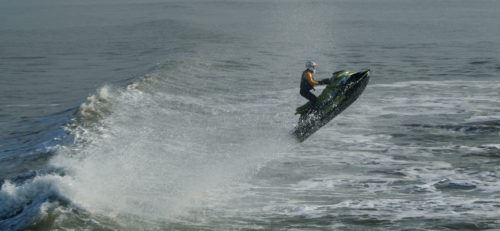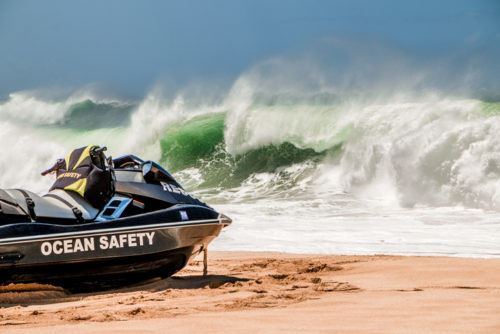In the mid-1960s, an engineer named Clayton Jacobson II designed the very first jet ski prototype. After several iterations of his initial design, the very first stand-up jet ski was manufactured in 1973. Throughout the years, this adventure vehicle has become more sophisticated, widely used and the number of jet ski accidents has increased drastically.
It is a common tourist activity and beachgoers around the world jump at the opportunity to rent and ride a jet ski on the open water. Perfect for both ocean and lake use, jet skis come in many different styles to fit all sorts of uses.
From recreation and sport vehicles to official waterway rescue vessels, jet skis offer a more convenient ride than the heavy-duty handling of boats and ships. But despite their widespread use, these vehicles can be as dangerous as motorcycles and jet ski accidents are not rare.
Because riders are exposed on all sides of the craft, they are more prone to injury. And since many riders have limited experience operating jet skis, they can find themselves in precarious and life-threatening situations. When you’ve been in a jet ski accident, you may need to seek legal representation in order to win damages to cover the cost of your injuries.
Causes of Jet Ski Accidents
Although it is a fun activity, jet skiing and driving personal watercraft (PWC) should be treated like driving a car. If you are in a crowded area, you need to pay special attention to your surroundings. Because they travel fast and can go airborne, these vehicles can create dangerous situations.
Since the 1980s, jet skiing has become a more popular sport. This means that there are more inexperienced riders who have gained access to the rental equipment. Along with increased access comes increased danger, as operators don’t always know the rules of the waterways or how to fully use their vehicles.
One of the most common causes of jet ski accidents is when riders don’t follow local operating laws. This is easier to do if you are riding in your own area, but when you visit a new area, you still need to know the regulations.
Florida is particularly prone to these added dangers, given the number of tourists that flock to its beaches for summer vacation. Many times these visitors either borrow equipment or rent from local vendors without any prior knowledge of how to operate a PWC.
Here are some of the most common issues that lead to jet ski accidents:
- Inexperienced operators
- One or more parties intoxicated
- Local boating regulations not followed
- Vehicle malfunction or failure
- Lack of safety gear (helmet, life vest, etc.)
When one of these elements is present, it can significantly increase the likelihood of injury or death. Anyone operating a PWC needs to be alert, aware and focused on the task at hand.
There is also an element of responsibility that rental companies have to keep riders safe. They should provide safety briefings to any inexperienced riders and perform regular maintenance checks on the vehicles.
Common Injuries and How to Avoid Them

Jet ski accidents are often very intense and result in harsh injuries. Half of all these accidents involve a collision between two PWCs (other jet skis, boats, ships, etc.). Other types of incidents happen during:
- Collisions with stationary objects (buoys, docks, etc.)
- Airborne-related incidents
- Sharp turns
- Failure to stop or course-correct
Oftentimes collisions happen when the PWC operator doesn’t know how much time they need to bring the vehicle to a stop. When this happens, they can end up hitting another rider or object nearby.
Waterway laws usually stipulate that jet ski riders cannot jump another vessel’s wake if they are within 100 feet of the boat itself. This is intended to prevent the PWC driver from hitting the other vessel on accident. It’s also normal to have laws against making sharp turns near other riders.
These types of accidents often result in severe injuries and death. Common injuries include:
- Lacerations
- Broken or fractured bones
- Amputations
- Burns
- Head trauma
- Spinal injuries
- Whiplash
While these injuries are common, there are ways you can avoid them.
- Personal Flotation Device: you should make sure to always wear a personal flotation device (PFD) while riding a jet ski. Wearing one can save you from drowning and protect your chest and abdomen from lacerations or broken bones.
- Helmet: this protects your head from any trauma and decreases your chance of getting whiplash. Helmets also allow you to wear a pair of goggles over the helmet, allowing for a secure fit. You can use the goggles to protect your face and block the sun from your eyes.
Overall, having face and head protection can be a great benefit because riding a jet ski is a very exposed activity. It will protect your jaw and prevent sunburn, as well.
History with Jet Ski Cases

In 2011, our legal team at Zimmerman and Frachtman won a major jury verdict in a jet skiing case against Yamaha Motor Corp. The case, Perez v. Yamaha, centered around a WaveRunner accident that occurred in 2005. The legal proceedings lasted five years and the trial itself lasted for six weeks total. We were able to win $39,000,000 for our clients at the end of the process.
During the accident, a 14-year-old named Jaysell Perez died and his friend Samantha Archer sustained life-altering injuries when their jet ski crashed into a boat. We were able to successfully argue that Yamaha failed to correct a steering defect with the WaveRunner used in the incident. It also failed to notify riders that they needed to use the throttle in order to steer the vehicle.
We also helped win a private settlement in 2006 following the death of a 12-year-old who crashed a jet ski into a dock. Our understanding of these types of incidents will help future clients win the damages they deserve.
If you or your family have been impacted by a jet ski accident, you can trust our experienced and knowledgeable legal team to assess your case. We have more than 25 years of experience practicing personal injury law and are open to many types of injury cases. Contact us today to tell us more about your needs.

